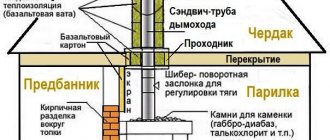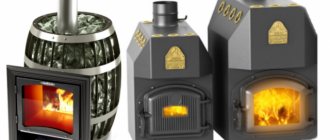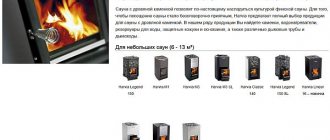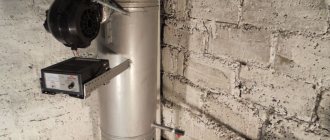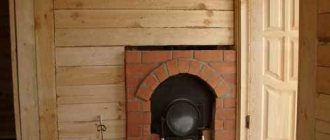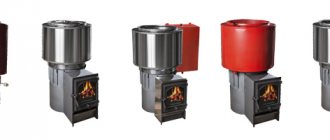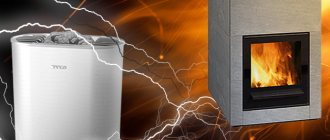The simplest and at the same time cheapest way to make a sauna stove is to use a piece of ordinary steel pipe. Such a design will function quite normally in any room, regardless of its size. Moreover, thanks to the sealed casing, a stove made of pipe will not emit carbon monoxide during operation, which means it is absolutely safe for humans. Therefore, there is no need to build any additional fences.
How to weld a sauna stove from a pipe
How to weld a sauna stove from a pipe? In reality, there is nothing complicated here - if you have the appropriate equipment and skills in working with a welding machine, the manufacturing procedure will take only a few hours.
The difference between horizontal ovens and vertical ones
From a space-saving standpoint, it is more profitable to install a vertical structure, but the specific shape of a horizontal oven provides several advantages:
- convenience of fuel loading;
- low stove height and optimal location of the heater box;
- Since in a horizontal stove the fuel is distributed evenly, the wood burns better.
Attention! Because there is better air flow around a round horizontal oven, more heat flows to the water tank and stones.
Modern craftsmen create horizontal structures because many people like the look of such a stove. Due to the simplicity of the design, creating it according to your drawings will not be difficult. Often old natural gas cylinders are chosen to build such a furnace. It is possible to install a piece of pipe from a water supply with a diameter of 50 cm. The most popular design is a horizontal stove made from a 53 cm pipe. Thanks to its horizontal position, it is durable and has optimal heat transfer.
How to choose a pipe?
Above we have already encountered digital designations for pipe sizes. Now let's take a closer look at what they mean and how to effectively use this information for further purposes.
In specifications, round steel pipes are always classified by internal diameter; The 2nd number indicates the wall thickness, and the following symbols, if any, indicate the type and special characteristics. For profile pipes, the first 2 digits are the maximum cross-sectional dimensions, then the 3rd is the wall thickness. The default units are millimeters; others are indicated explicitly. For example, “body - pipe 530x10” means that it is made of a pipe with an internal diameter of 530 mm and a wall thickness of 10 mm, i.e. the outer diameter of the workpiece will be 550 mm plus or minus 5.3 mm, because The tolerance for the diameter of a regular pipe is 10% of the internal diameter. The tolerance is mainly spent on the ellipticity of the pipe.
Further, the wall thickness can be different. Water pipes are produced in lightweight, regular and reinforced types. But, for example, the most common pipe 530 is produced with walls thickness from 6 to 12 mm in increments of 1 mm; the most common denominations are 6, 8 and 10 mm.
Why know all this? To choose the right blanks for the oven. The optimal diameter of a household stove is about half a meter, this allows you to get both good heating technology and sufficient ease of use. And for pipes from 500 mm, the nominal pitch of standard sizes is 10 mm, i.e. there are pipes 500, 510, 520 and 530; large ones are considered to be large-diameter pipes. That is, by selecting workpieces of different diameters and with different wall thicknesses, you can create a concentric structure, the parts of which will telescopically fit into each other with a minimum gap. And typing in the search, say, “buy steel water pipe 510x8 cuttings” is easier than bending a shell from an 8 mm sheet, isn’t it?
GOST 10704–91 (straight-seam steel pipes) and GOST 20295 85 (steel pipes with a spiral seam) specify the pipe diameter from 1 mm; The steps of the dimensional grid for different ranges of standard sizes are of a recommendatory nature. Pipe is one of the most popular products in general, and it would be simply stupid to regulate them scrupulously. In the range of 250-400 mm, the range of pipe sizes produced is very extensive. Let’s see below how this circumstance is used in amateur pipe and furnace projects.
Note: for a homemade stove, whenever possible, you should choose scraps of spiral pipes. They are more precise, less elliptical than straight-seam ones, made of higher quality steel, and still sold at the price of scrap metal. Solid drawn (seamless) pipes are even better, but are only suitable for small parts, maximum diameter is 250 mm.
Advantages
When comparing furnaces with different housing arrangements, several distinctive features can be identified that affect the efficiency of air heating:
- Flows of flame and heated gases are directed to the chimney along the shortest path. At the same time, they have less contact with the walls of the structure. The flame flow is located in the very center of the horizontal furnace.
- In horizontal furnaces, flows of heated gases rush to the top of the body. Only then are they thrown out into the chimney due to rarefaction of the air.
- The heat from the heated walls goes normal to them, which means 90% of the heat is radiated in the horizontal direction. Due to this, the walls of the bathhouse quickly warm up. However, the floor receives little heat.
- A stove located horizontally is capable of thoroughly heating all areas of the sauna room, except those adjacent to the floor.
The weight of the structure can be 60-180 kg. For this reason, the horizontal structure is installed in the center of the steam room on a fairly simple frame. If you make 20 mm insulation, the structure can be installed even on a regular 8 mm sheet of steel.
Types of chimneys
Let's look at some design features and advantages of each type of ventilation pipe.
Made of brick
There are 2 masonry methods used in the production of a brick chimney:
- Indigenous. Such structures are laid out next to the heater and connected to it using pipes. They are used in the construction of stoves made of cast iron parts and in the production of brick heaters. Such designs can serve several devices simultaneously.
- The mounted type is laid out during the construction of the heater. They can only serve one device.
A brick chimney requires experience and production skills. It is important to reliably seal the seams and lay each brick evenly on all planes. It is important to adhere to the layout of parts at all stages of pipe construction. The advantages of this design include:
- creates constant and sufficient traction, regardless of wind strength;
- brick is a durable material that can serve for a long time;
- the material is absolutely resistant to open fire;
- bricks are able to accumulate and gradually release heat;
- Such pipes for bathhouses are more attractive than steel ones.
Made of metal
They are easier and faster to install, and the price of such materials is more attractive than a brick chimney. And more modern sandwich pipes are made with a thin but sufficient layer of insulation sandwiched between layers of metal. But in terms of reliability and durability, steel pipes are inferior to brick ones.
Among the advantages are:
- installation speed;
- low material prices;
- the smooth internal surface prevents the rapid deposition of soot on the walls, but due to the temperature difference, a layer of condensation is deposited on the steel walls.
For regions with low temperatures, it is recommended to equip baths with brick or chimneys with an increased layer of thermal insulation.
Other
Pipes for sauna stoves are produced from stainless steel with an internal layer of thermal insulation. Such materials are safe for people. Using double-sided steel pipelines, external gas removal systems can be installed. It is recommended to use parts with a wall thickness of 8 mm or more, with a thermal insulation layer thickness of 5 mm or more.
They use stove pipes for saunas made of ceramics. Such products are imported into the country from Europe, so the price does not allow the use of such parts by a wide range of consumers. The inner surface of the ceramic chimney is absolutely smooth, so condensation does not stay on them and rolls into the firebox.
Construction of a horizontal stove for a bath
The special design of horizontal stoves allows the heater to be heated more efficiently. In these furnaces, the firebox has a tubular shape. Below it are grate bars, usually made of reinforcement or cast iron strips. The water container is placed on the top of the body or at the end. With this arrangement, the water will heat up quite quickly.
Tools and materials
When creating a horizontal furnace, the following materials are used:
- Pipe section. Its diameter should be from 50 to 53 cm. The length of the body is 80-100 cm. For a steam room of 20 cubic meters. The first characteristic is sufficient. If you need to heat the dressing room as well, it is better to add 15 cm to the pipe length.
- Rectangular sheet of steel 120x70 cm. A small layer of rust is allowed. The main condition is that the surface is smooth, without holes or dents. Metal should be chosen at least 3 mm thick.
- Metal profile. Angle No. 50 is often used. For one horizontal oven you will need 1.5-2 m of profile.
- Reinforcing bars with a diameter of 6-8 mm. You can use cuttings of half a meter.
- The pipe is 150 cm long and 110 mm in diameter. You will also need several knees. The rotation angle and their number should be selected in each case separately.
- Two doors - for the blower and firebox.
- In addition to metal elements, you will need to find 20 electrodes for ferrous and 5 for stainless metal.
- Discs for working with an angle grinder with a diameter of 125 mm.
It is possible to build a horizontal oven only if you use certain tools. The main ones include a welding machine and additional accessories. During the work you will need to saw steel sheets, so you should include a powerful grinder in your list of tools. A carbon dioxide semi-automatic machine is the ideal choice when you need to cook critical components. A simple pulse unit is sufficient if you have the operating skills.
Important! If you choose old pieces of pipes, you should make sure that they do not have any deformations. It's better to use new material.
When installing a horizontal stove for long-term operation in a bathhouse, it is necessary to purchase high-quality pieces designed for medium pressure.
Arrangement of the foundation for the furnace
The next stage of furnace production is the arrangement of a reliable foundation.
- At the site where the stove will be installed, a pit is dug up to 55 cm deep, 75 cm long and 75 cm wide.
- The bottom is covered with fine-grained crushed stone up to 35 cm high and compacted.
- The crushed stone cushion is filled with concrete mixture in the following proportions: 1 part cement, 5 parts sand and water. The base is kept for 24 hours until it hardens.
- Sheet roofing material is laid on the finished foundation, which is used as a waterproofing layer.
- The waterproofing is poured with a concrete mixture: 1 part cement, 3 parts sand, 5 parts fine gravel and water. The bases are carefully leveled and left until completely hardened.
- A brick platform measuring 75 × 75 cm is built on a concrete base. Brickwork is done in a single or double row using a clay-based connecting mortar.
- A shielding shield is made to protect the bath walls near which the stove will be installed. For the screen, refractory bricks are used, laid on the side edge. Shielded protection can have a height of 1.2 meters, while heating equipment is installed at a distance of 25 cm from it.
Stove design with horizontal firebox
Most horizontal ovens have an identical design. There may be slight differences depending on the version - the location of the water tank and the design of the ash pan. Before work, you should compare different projects and study the drawings.
The location and parameters of the grate are of great importance for the efficient operation of a horizontal furnace. If you make them too wide, traction will be reduced. The width of the grate should not be more than 12 mm. They should be located along the entire length of the combustion chamber.
When choosing between steel and cast iron grates, you should give preference to the latter. Such elements will last much longer. To prevent clogging of the suction with ash, the ash pan is welded in the form of a separate box. It is connected from below.
Often the window for loading fuel is made in the form of a box tunnel. Thanks to this, it is possible to open the firebox and vent doors into the utility room. This eliminates the appearance of dirt and cinders from the washing room.
The heater box is installed on top of the structure, closer to the chimney. The front of the body is always colder. Often it only serves to heat the air in the room. In some horizontal stoves, the chimney outlet is bent. This allows you to increase the contact area with stones and the water tank.
Cleaning and care
The main job is to clean the internal surfaces from soot. When the draft level decreases for the first time, you will need to immediately clean the channels from adhering soot. Such preventative work is carried out at least once every 30 days.
The work is not difficult. To clean, we pass a cable or wire through the top. At the bottom we tie a metal pipe cleaner along the diameter of the pipe and stretch it along the entire length. You can tie a weight to a cable and clean the soot from above, lowering a heavy blank. After the work, a general cleaning of the steam room will be required, so it is better to cover the shelves with polyethylene and take out light items.
People use several other cleaning methods. In winter, having rolled a snowball along the internal size of the pipe, it is lowered into the pipe and, as it descends, it will clean off the soot from the walls. The simplest and most effective way is to burn a stack of aspen firewood in the stove. Aspen releases moisture, which settles on the soot layer and causes it to collapse.
You can install a powerful fan and direct the air flow into the pipe. Just don't forget to warn your neighbors about your operation. Otherwise, you are guaranteed to get into trouble and wash your neighbor's clothes.
Furnace assembly
A hanging container for water and a compartment for the heater are installed on the horizontal structure. This stove is quite compact, and by increasing the depth of the firebox, the room is heated faster. When manufacturing a structure, a number of sequential actions should be performed:
- A piece is cut out of a steel pipe, measuring a length of 80 cm. The edges should be carefully aligned and cleaned.
- Weld the grate. To make the platform correctly, a rectangular piece of 80x40 cm is cut out of a 1.2 cm metal sheet. A hole is made inside, leaving only the frame. Reinforcing bars are welded to it. Finished products are sold at any hardware store.
- Weld the grate platform into the body. The seam of the body pipe should be located above the grates. They heat up more, which ensures greater heat transfer from a horizontal oven.
- A façade of 0.6x0.7 m (width and height, respectively) is created from a steel sheet. Its top is made rounded. It creates 2 rectangular cutouts for the doors.
- The dimensions of the rear element of the housing differ from the dimensions of the facade. They are equal to 0.7x0.9 m. This element on top will limit the compartment for stones.
- The rear element and facade are welded to the body. A restrictive grid for the heater is installed in the center of the structure.
- The rear element with the facade is welded to the body. A front limiter for the stone compartment is installed on top.
- A hole is cut in the upper part of the stove to install the chimney pipe. It is better to make it 15x15 cm in size. Then install the furnace roof.
- A chimney is welded to it. The arch will also serve as the bottom of the compartment for stones. A grid 20 cm high is installed on the walls of the vault.
- Install the doors. Clean the stove with a grinding wheel to get rid of rust, and then treat it with heat-resistant paint. First, the oven is heated outside to bake the paint.
- Install a water tank on top of the rear part. To do this, weld a shelf equal in size to the bottom of the water container. When laying the heater with stones, they should be laid with flat surfaces as close as possible to the metal walls. This will make the stones heat up faster.
Taking into account the features of each stage, it will be possible to assemble an effective and durable structure.
Advantages of homemade tube furnaces
A metal furnace can be made from pipes, sheet steel and waste gas cylinders. The best option is a device made of thick-walled steel pipe. It has a number of important advantages:
- High mechanical strength of the material, capable of withstanding sudden changes in temperature.
- Low thermal expansion and high thermal efficiency.
- Good heat capacity to preserve thermal energy after long-term combustion of fuel material.
- Resistance of thick-walled metal to corrosion, destruction and deformation under excessive exposure to high temperatures.
- Effective distribution of energy throughout the entire volume of the room and creation of natural draft inside the structure.
- Reliability, practicality and long service life of the finished product.
- Affordable cost of material, ease of manufacture and installation.
Requirements for installing the stove
The rest of the furnace installation work is carried out in accordance with the following requirements:
- Mount the stove on a pre-created base. It is installed twenty centimeters from the wall.
- In the place where the chimney will be vented outside, a thickening of 120 mm is created.
- The pipe between the ceiling of the bathhouse and the roof is treated with lime.
- The height of the part of the pipe that will protrude above the roof should be at least half a meter.
- The shelf must be installed next to the wall where the stove is located. The person sitting on it should not reach his head to the ceiling.
Such conditions allow you to install the stove in the bathhouse more rationally, without making common mistakes.
When creating a stove from a pipe, you can make a mistake. As a result of an oversight, the design will not function effectively enough. Therefore, in the process of creating a stove, you should consider some tips. For example, installing a movable valve in the chimney pipe will help prevent the rapid blowing of heat out of the structure.
When a lot of soot accumulates, it can catch fire. To prevent this situation, it is worth equipping a horizontal furnace with an afterburner. For this purpose, two holes are made in a certain section of the pipe wall, into which metal tubes are subsequently installed, bent towards the pipe. This eliminates the formation of soot. As a result, more oxygen will enter the firebox, and the wood will burn out completely.
Taking these tips into account, you can assemble a stove that can effectively heat a bathhouse. At the same time, not much firewood is consumed. The volume of the water tank depends on the features of the housing.
teplomex.ru
Pipe sauna stove
Many of us value the sauna not only for its cleansing properties; a huge number of people constantly visit the sauna for many reasons. The main one is that each session can be equated to a whole ritual. Each component of this process improves your well-being.
Healing steam, the use of a broom and high temperatures - all this strengthens human health. The desired effect can only be achieved thanks to a high-quality oven. It is she who warms up the steam room to the temperature that has healing properties. If you are interested in the question of how to make a sauna stove from a ⌀ 530 or 700 mm metal pipe with your own hands, then we will help you.
Since stoves are the main part of any bathhouse, you need to start by planning its location in the room. It should occupy a specially designated place, which will be protected from all other elements. Many people advise not to strain and buy a ready-made stove for a sauna. This is expensive in many cases. Moreover, considering the fact that it can be quickly and cheaply built with your own hands.
Main functions of a sauna stove:
— heating the air to the set temperatures; — heating the water: it is used for various procedures.
The advantage of refusing a purchased product is that factory-made stoves are no different in their operating principle from home-made options. They function on the same principle. The only advantage of purchased units is the presence of all kinds of additional options.
Have you decided to save money? No problem! There is only one way out - to make a high-quality sauna stove from a pipe yourself, taking into account all the calculations, drawings, diagrams and requirements for its installation vertically and horizontally.
Metal stoves for baths
Bath products come in various configurations and can consist of various materials. One of the most used options is metal. You can build such a product quite quickly, spending a minimum of money. We look at photos of metal stoves.
Bath stoves made of heat-resistant steel
Metal heating structures have a number of advantages:
1. Increased resistance to heat;
2. Unlimited service life and unique wear resistance (depending on the quality of the selected metal);
3. High heat transfer rates. The room heats up instantly. Small products can warm up a room in just 1 hour;
4. Large selection of fuel used to heat the steam room;
5. Availability and low cost of the main material;
6. Moderate weight of the structure. Unlike a stone sample, there is no need to lay out a special riser under a metal stove;
7. Easy to install.
The last point can be called the most important, since it is the convenience of installing the finished configuration that determines the benefits of this type of furnace. The easier it is to equip a bathhouse with all the necessary parts and units, the faster you can begin to improve your health.
The metal type of stoves also has several disadvantages:
1. Quick cooling of the product. As soon as the fuel supply stops, the temperature in the furnace begins to drop. Therefore, in almost all metal structures it is necessary to frequently add firewood or other fuel.
2. Uneven distribution of heat. The problem is noticeable only if the product is used in baths with large steam rooms. Small rooms heat up quickly and can remain hot for a long time.
It is important to know! It is better to equip large baths with several stoves at once. Let them be small, but they will warm up the area from different directions.
Design of a metal stove for a bath
Just as you can build a good stove with your own hands using a welding machine and care, let’s look at what the structure consists of. Main elements of a sauna stove:
- firebox;
- a container for stones, which can be built into a body and be located directly inside the product, or can be brought out;
— a special chamber for air injection.
The connecting elements are gratings, also known as grates, they are built between the chambers. The only part that stands alone is the tank, which is used specifically for heating water. Some experts advise making it an integral part of the body.
Do-it-yourself sauna stoves made of steel pipe ⌀ 530 mm.
Basically, the tank is mounted on supports that are located above hot stones.
When the stove is running, the water gradually heats up. The built-in configuration assumes accelerated heating. There are also often wall-mounted tank options that connect to the heating structure via flexible stainless steel gas hoses or steel pipes with a minimum passage diameter of 3/4″. The last element without which you cannot create a stove is the chimney. The pipe is vented outside, removing combustion products.
How are metal sauna stoves built?
Since a material such as metal is considered affordable, reliable and durable stoves are often made from it. The design creation process consists of several main stages. There are different approaches when designing furnaces.
They can be made from sheet steel ⌀ 400, 420, 530 or 700 mm, and can also be used in barrels. The latter option is perfect for an economical heating system option. Regardless of the method chosen, be it a gas cylinder, an old barrel or a sheet of iron, there are two directions in which the stove can be built:
— horizontally; — vertically.
Each option effectively warms the room and provides maximum efficiency during the combustion process.
Horizontal ovens
As practice shows, the horizontal arrangement of the structure contributes to long-term combustion of fuel, as well as better heating of the room. As a result, such metal products remain hot much longer than other types.
Horizontal stoves for a pipe bath: drawings
For horizontal structures, the same materials are used as for vertical samples.
There are many different configuration options available on the Internet. Let's look at one of the most common types. For a metal stove you will need:
1. The main section of pipe, the length of which is 75 cm. Its diameter must be at least 530 mm for uniform distribution of fuel in the finished structure.
2. Additional pipe, which has a smaller diameter - only 12 cm.
According to the welding principle, horizontal products are slightly more complicated than vertical ones. But such designs have an advantage - the tank for heating water can be located on any convenient side. Basically, it is installed either on the firebox or near it.
First you need to put the main pipe in a horizontal position and weld the support legs to it. After this you need to make a grate. The grate can be made of metal of the same thickness as the pipe.
You should cut a rectangle 75 cm long and a width equal to 1/3 of the diameter. This grate will serve as the bottom for the firebox. Next, the part is welded to the pipe. After preparing the grating, it is necessary to weld the ends of the structure.
The next stage is creating a chimney and arranging a basket for stones. These steps are completed quickly:
— a special branch is constructed from a pipe of smaller diameter and welded to the main structure; - take reinforcement and use it to create a neat and durable basket.
Vertical ovens
Vertical stove for a bathhouse made from a pipe: drawing
Above, according to the drawing diagram of a stove for a bathhouse made from a pipe, we see:
1 - stones; 2 - casing; 3 - firebox; 4 - grate; 5 - ash box; 6 - chimney.
The whole process proceeds in the same order. First of all, you should prepare all the necessary tools and materials:
- welding machine; — high-quality electrodes; - grinder; - 2 steel pipes, their length should be 90 and 60 cm; - a pipe for the heater, the diameter of which is 35 cm; — fittings; - pick up a chimney pipe. — buy door hinges.
Metal waste oil furnaces
Recently, both home-made and purchased products that use waste fuel as fuel have become widespread. The good thing about this method is that this configuration can provide long-term heating of the room.
The entire structure consists of the following components:
1. Burners. 2. Heating module. 3. Fuel tank. It is located at the bottom of the structure.
Important! Heating systems using exhaust must have special holes in the lower part. With their help, you can not only add fuel, but also regulate the intensity of combustion of the material. The upper part should be equipped with a small pipe for exhausting gases.
Operating principle of the furnace during mining.
When the tank heats up, the top layer of used oil begins to boil. All resulting vapors react with oxygen in the burner. Combustion occurs. You can build a stove for a bathhouse from a pipe with your own hands at minimal cost, and provide high-quality heating of the steam room in just one day. All you need are drawings, high-quality materials, welding and care.
conclusions
The level of tilt of the body does not affect the operation of the stove. Therefore, you can install it arbitrarily. It is possible to treat the chimney with a high-temperature compound. This will help eliminate the metallic smell. After several fires, the pipe burns out and turns red. No further oxidation of the metal occurs.
As you can see, you can build a horizontal stove for a bathhouse yourself, if you get acquainted with the main stages of work and the features of preparation. It is important to choose the right materials and find all the necessary tools. If you have basic welding skills, you can make an effective structure that will last for decades.
Recommended Posts
DIY cellar
Wall mounted metal shelves
How to make a birdhouse with your own hands
How to make a swing nest with your own hands
How to make a cellar lid with your own hands
How to make a fountain in your country house


